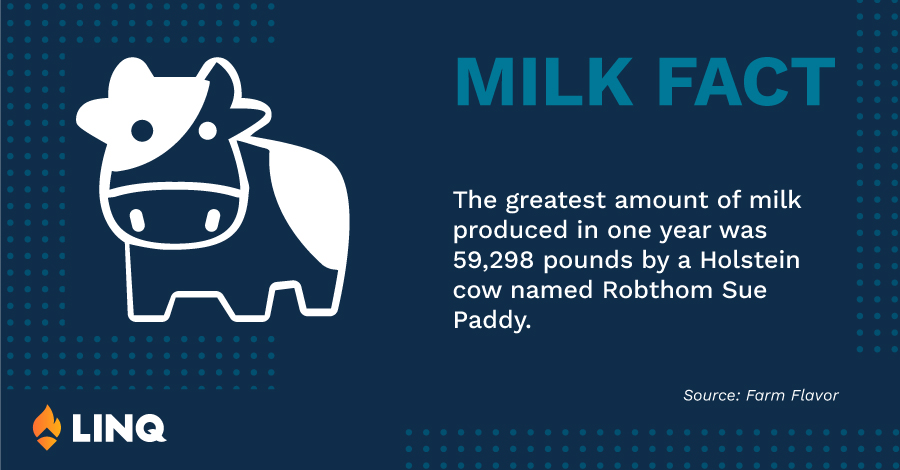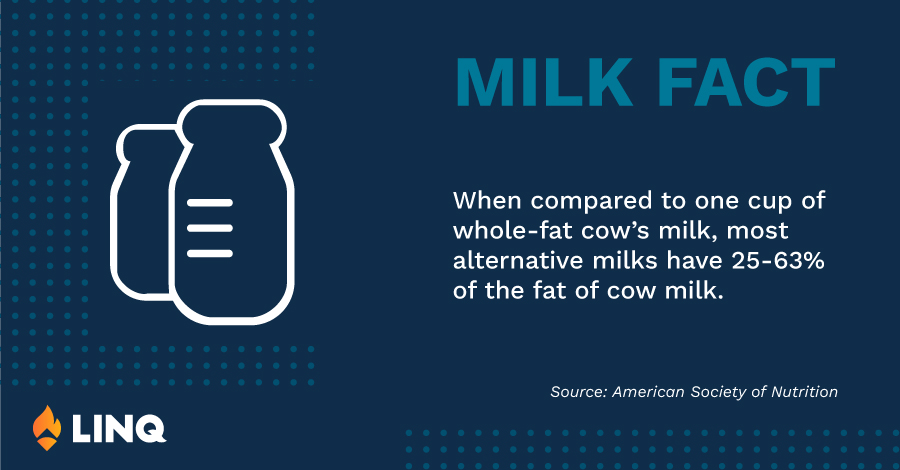World School Milk Day celebrates one of the most nutritious beverages on the planet. The world recognizes milk’s important place in school nutrition programs on the last Wednesday in September. This year, September 27th marks the 24th annual World School Milk Day. Students in classrooms and lunch rooms around the world will experience fun and education around this core nutrition ingredient.
Milk offers a healthy dose of nutrients and is a key ingredient in many dishes considered staples in U.S. schools. Student favorites like ice cream, mac and cheese, pancakes, cheese dip, yogurt, and pudding all rely on milk as an essential ingredient. And it’s largely the milk in these dishes that provides belly-filling and body-nurturing protein, fat, vitamins, and minerals. Calling out the nutrition benefits of milk in your menu items can help drive school nutrition program participation.
Let’s look at the history of this annual holiday, how schools celebrate it, and some amazing facts about milk.
What is World School Milk Day?
The Food and Agriculture Organization of the United Nations (FAO) launched World School Milk Day in 2000. Schools worldwide are generally in session by the end of September, which is why they chose this time of year and placed it permanently on a school day rather than a specific date.
The holiday creates novel opportunity for schools to promote milk and their nutrition program. They can highlight nutrition education and to discuss what makes some foods healthier choices than others.
How do schools celebrate World School Milk Day?
Free milk for students, education focused on milk, and even costumed characters and mascots are some of the ways to celebrate World School Milk Day. It’s a day to recognize milk’s role in a healthy diet and have fun.
Schools may choose to celebrate milk-producing farms and farming communities by teaching students about where their milk and other food originates, especially if your school or district uses USDA farm-to-table grants.
Here are a few creative ways to celebrate World School Milk Day:
- Create or purchase milk-themed posters and decorations to display
- Plan school breakfast and lunch menus featuring items made with milk
- Conduct a poll to find out your school’s most popular ice cream flavor
- Post milk trivia signs using the facts below near cafeteria lines or in school hallways
31 Amazing Milk Facts
Milk’s a powerhouse beverage loaded with nutrients, vitamins, and minerals—and it tastes delicious. It’s been a core component of human diets across cultures and time, dating back longer than recorded history. Here are some of the most shocking and interesting facts about milk for you to share and savor on World School Milk Day:
The Strange and Wonderful History of Milk

- Evidence shows that Neolithic farmers in Britain and Northern Europe may have been among the first to begin milking cattle for human consumption around 4000 B.C. (Source: ProCon)
- Before modern refrigeration, people in Russia and Finland placed Russian brown frogs in buckets of milk to keep them fresh. According to research, amphibian skin secretions are packed with peptides, antimicrobial compounds as potent against Salmonella and Staphylococcus bacteria as prescription antibiotics. (Source: Discover Magazine)
- Because of Louis Pasteur, the 19th century French biologist, the milk we drink today contains little or no harmful bacteria. Pasteur initially applied his bacteria-killing technique, known as pasteurization, to beer. (Source: Illinois Farm Families)
- In the 1700s, it was common folk knowledge that women who milked cows seemed immune from the smallpox plagues when they swept through Europe. In 1796, English physician Edward Jenner developed a vaccine for smallpox based upon this folk knowledge. (Source: ProCon)
- In New York in 1883, a struggle known as the “Milk Wars” broke out between milk farmers and milk distributors when milk farmers demanded a higher prices and distribution companies refused to pay. The farmers organized “spilling committees” that blocked roads, seized shipments, and dumped out their own milk instead of selling it to the distributors. (Source: ProCon)
The Numbers Behind the Gallon

- Milk comes from seven main breeds of dairy cows: Ayrshire, brown Swiss, Guernsey, Holstein, Jersey, and milking shorthorn. (A seventh, red and white, is a variation of the Holstein breed.) (Source: Illinois Farm Families)
- A cow will produce an average of 6.3 gallons of milk each day, or 2,300 gallons each year! (Source: Illinois Farm Bureau Partners)
- There are approximately 340-350 udder squirts in a gallon of milk. (Source: Illinois Farm Families)
- An average Holstein dairy cow weighs about 1,500 pounds, or nearly one ton. (Source: The Dairy Alliance)
- Cows that are milking eat 100 pounds of feed and drink between 30 and 50 gallons of water each day. (Source: The Dairy Alliance)
- Cows get a two-month vacation from milking every year. (Source: The Cattle Site)
- Farmers measure milk in pounds, not gallons. (Source: Farm Flavor)
- The greatest amount of milk produced in one year was 59,298 pounds by a Holstein cow named Robthom Sue Paddy. (Source: Farm Flavor)
- A cow is more valuable for its milk, cheese, butter, and yogurt than for its beef. (Source: Farm Flavor)
Milk is a Nutrition Powerhouse

- Despite its creamy texture, milk is actually 85-95% water. The rest of its volume comes from vitamins, proteins, carbohydrates and fat. (Source: Illinois Farm Families)
- To absorb the same amount of calcium as you get from one cup of milk, you would have to eat either 10 cups of raw spinach, six servings of pinto beans, or three cups of cooked broccoli in one sitting. (Source: Illinois Farm Families)
- Drinking milk can protect your smile since it reduces the level of acidity in the mouth, combats plaque formation and reduces the risk of cavities. (Source: Farm Flavor)
- Eight ounces of milk provides eight grams of protein. Milk is considered a “complete” protein, which provides the full dietary combination of amino acids. (Source: 97milk.com)
- In one serving of milk, you get the following recommended daily amounts of vital vitamins, based on a 2,000 calorie diet: Calcium: 25%; Vitamin A: 15% Vitamin D: 15%; Riboflavin (B2): 30%; Vitamin B12: 50%; Potassium: 10% Phosphorus: 20%; Selenium: 10%. (Source: American Dairy)
- Organic and grass-fed cow’s milk contains higher amounts of beneficial antioxidants, such as vitamin E and beta-carotene, which help reduce inflammation and fight oxidative stress. (Source: PubMed Central)
- A study including over 18,000 middle-aged and elderly women showed that eating more high-fat dairy products was associated with less weight gain and a lower risk of obesity (Source: PubMed Central)
A History of Milk in Schools
- After the U.S. entered World War II, the Department of Agriculture released a pamphlet promoting the Milk Program in 1942. It hoped to reduce malnutrition and hidden hunger among American school children through the program. (Source: Wikipedia)
- In 1954, Congress authorized the Special Milk Program, which contributed (along with the growth in school lunches) to a 10-fold increase in school milk consumption between 1946 and 1969. (Source: U.S. Dairy)
- The Special Milk Program is now permanently authorized under the Child Nutrition Act of 1966. (Source: Wikipedia)
- In 2011, over 66 million half pints of milk were served through the Special Milk Program. (Source: USDA)
- The expansion of both the National School Lunch and School Breakfast Programs, which include milk, led to a substantial reduction in the Special Milk Program since its peak in the late 1960s. The program served nearly three billion half pints of milk in 1969, 1.8 billion in 1980, and 181 million in 1990. (Source: USDA)
Milk Isn’t for Everyone

- Around 65% of the world’s population experiences some level of lactose intolerance. (Source: Medline)
- Research suggests people with lactose intolerance can tolerate up to 18 grams of lactose when it’s spread throughout the day. (Source: PubMed)
- There are several milk alternatives on the market for those who dislike or cannot tolerate cow’s milk. These include the following: oat milk, almond milk, soy milk, cashew milk, coconut milk, rice milk, and hemp milk. (Source: Healthline).
- When compared to one cup of whole-fat cow’s milk, most alternative milks have 25-63% of the fat of cow milk, with the exception of Hemp (8 g). (Source: American Society of Nutrition)
- Almond, pea, and flaxseed milk have more calcium than cow milk (560, 560, 450 mg vs. 425 mg). (Source: American Society of Nutrition)
Celebrate World School Milk Day to Promote Your School Nutrition Program
A promotion like World School Milk Day is an excellent opportunity to educate students on the benefits of milk while promoting milk-based items you serve in the cafeteria. Consider doing blind taste tests of alternative milks or things like smoothies. You can even share the facts from this post!.
Use your school nutrition management software to plan an entire day’s menu around the event. Find out how LINQ makes creative menu planning, adjustments, and on-the-fly changes easy.
